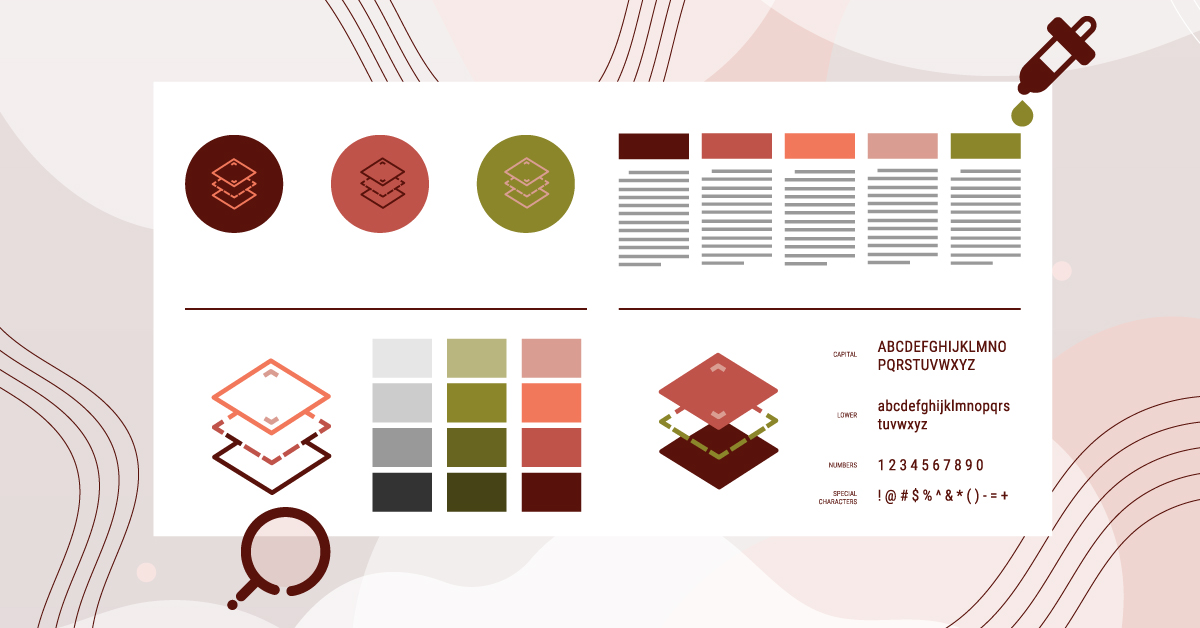
Lúgh Studio’s Ultimate Guide to Making a Brand Style Guide
02/28/22
Brand Identity
Creating a brand style guide can seem like an overwhelming task. There are a ton of parts that go into doing it effectively and often it can be difficult to know where to start.
Click Here for Your PDF Version of this Guide
Today we are giving you a roadmap to follow. We’ll show you why having a brand style guide is so important, as well as a checklist and some tips for making the process more effective. Let’s get started.
Why A Brand Style Guide Is Important To Have
What Your Brand Style Guide Should Contain
How To Make A Brand Style Guide
Where To Keep Your Brand Style Guide
Tips For Your Brand Style Guide
…
Why A Brand Style Guide Is Important To Have
Let’s first cover what a brand style guide is so essential for your organization. This is often a project that is pushed to the side for more “urgent” tasks, so understanding its many benefits is the first step towards creating one.
Ensures consistency
A brand style guide creates a “universal source of truth.” This creates a working situation in which everybody knows exactly the kind of elements they need to use in different circumstances. The benefit of this is that a valuable consistency across all channels, teams, marketing assets and client work is established.
Gives your brand a professional look
Hand in hand with consistency is professionalism. Brand style guides are a part of just about every single well-known company. This is apparent in how consistent famous brands are in their design and marketing.
Sets expectations
 Clients want a company that is predictable. They want to work with a brand that knows exactly what it’s doing and has systems in place. A brand style guide is a fundamental part of these “systems” because it shows clients that you take your own brand as seriously as their own.
Clients want a company that is predictable. They want to work with a brand that knows exactly what it’s doing and has systems in place. A brand style guide is a fundamental part of these “systems” because it shows clients that you take your own brand as seriously as their own.
Avoids wasting time
You don’t want an endless email back-and-forth about which font to use or where to get access to your brand’s logo. This is the sort of problem that a brand style guide prevents. Think about it with the work that you do at your own company or agency. How often do you email potential customers? How often do you write blog posts? Communicate across different channels with clients? These are all things that can be systematized, and in doing so you save hours of valuable time.
What Your Brand Style Guide Should Contain
Now that we know why a brand style guide is so important…what should it actually contain? While a brand style guide will be unique to your organization, there are some elements your guide should usually have. Let’s cover some of them now.
1) Reasoning behind it
This is usually good to include to get “buy in” from your entire team. Your designers likely already know the value of having clear and consistent guidelines for your brand style. The same might not be true for other teams or departments.
This should be the very first thing somebody sees when checking out your brand style guide. It reminds readers of why the brand style guide is so important and makes it more likely that they will actually implement it.
2) Assets
You will want a collection of the most important assets your company uses. This will usually include things like a logo, common images, templates you use, and headers.
While this can seem relatively straight forward, it’s important here that your entire team agrees on what actually counts as an asset. To get to this point, you’ll need to sit down and discuss it.
Be sure to check out this article for other ideas of what your assets might include. And remember, they should also be easy to export and actually use. No use gathering your assets in one place if nobody can actually use them.
3) Typography
What type of fonts does your brand use? This, like everything else, should be consistent. If there are certain exceptions to the fonts you use (for example, perhaps your content employs a typography specifically suited for better longform reading) make it as clear as possible.
It’s also important to state which commonly available fonts are preferred if a client (for example) doesn’t have access to the typography laid out in your brand style guide. Check out this article for the best fonts you can use.
4) Color palette
 Your brand likely has a collection of colors that are used most often. This includes your logo but can also appear on email headers, whitepapers, blog posts, web pages, etc. Ideally you should keep your color palette to just a few colors. The more colors you have the less professional it looks. Three or four should do just fine.
Your brand likely has a collection of colors that are used most often. This includes your logo but can also appear on email headers, whitepapers, blog posts, web pages, etc. Ideally you should keep your color palette to just a few colors. The more colors you have the less professional it looks. Three or four should do just fine.
This might require a bit of rebranding, especially if your company has used many colors up until this point, but it’s worth it. After all: simple sells!
5) Mission / vision
What is it that your company stands for? A brand style guide is not just about the images and colors you use, but the stated vision behind your company. This might include why your company exists, the origin story, who you help, and how your company is different from the competition.
While it’s possible you already have a mission statement, now can be a great time to rethink one. Just like your color palette, your mission statement should ideally be relatively simple. Who do you help, what problem do you solve, and what benefit does solving this problem bring to your target audience? This should be answered in your mission statement.
And if you don’t have one? Then it’s time to get to work!
6) Messaging
Messaging is a bit trickier to systematize because it can mean many different things. Essentially, your messaging is how you want to present your company and brand to the public eye.
What are the common phrases and words your brand wants to be associated with? This might be taken from your mission statement and adapted to the relevant situation (blog post outros, lead magnets, “About Us” page, etc.).
The reason this is so useful is that it gives your entire team a common language to use. This can be handy in any number of areas, but it’s especially applicable when talking to potential new clients. They want to know what you stand for, as well as some of the more in-depth details of the product or services you offer. Include messaging in your brand style guide, and you will know exactly what to say!
How To Make A Brand Style Guide
It’s now time to get to work. Like I said before, each brand style guide will be slightly different because the companies that implement them have different goals. Still, follow the general process listed below and it will make the process easier and more effective.
1) Sit down with your entire team. The very beginning of the process is the time to discuss whether or not you are all happy with the visual / non-visual elements you currently employ. No need putting your style guide into writing and then distributing if you want to improve on it.
This should be an open conversation. Everybody should be able to share their honest thoughts without fear of consequences. If your designer has never liked your logo, for example, now’s the time to talk about it.
2)  Examine the brand style guides of other companies. Checking out what other companies do can also be a great way to get inspired. Look at their blog content, email newsletter, or even their website design.
Examine the brand style guides of other companies. Checking out what other companies do can also be a great way to get inspired. Look at their blog content, email newsletter, or even their website design.
What would you like to replicate? Anything you could add, or maybe even take away? What sort of feeling do you get as an outsider looking at their online presence? Going through this exercise is not only good inspiration, but will prepare you for the next step.
3) Decide on the changes to be made. This should ideally come right after the conversation with your team and examining outside inspiration. As I mentioned before, this will span an entire range of visual and nonvisual elements. Spend your time prioritizing what needs the most attention.
Of course, it’s important to approach your brand style guide with at least a little bit of analytical reasoning. Instead of only doing “what feels right”… what actually works? For more background on this, be sure to give this guide to “effective logos” a look.
4) Set a firm deadline. A brand style guide isn’t something you want to have “mostly done.” All it takes to cast your reputation in a negative light is one incorrect font or inconsistent color pallette.
You need to get it right. That’s why you have a deadline. This is the date after which it should “go live” and everybody starts using it. The timeframe needed to create this project will vary depending on how extensive it is, so be sure your time deadline is realistic.
5) Assign responsibilities. To successfully create a brand style guide, your team needs to treat it like any other project. Who is doing what? What resources do they need? Which teams will be working together, and what are the main “checkpoints” that need to be reached to keep you on track?
Approaching your brand style guide with the professionalism of any other client work will ensure that you complete it on schedule. It will also get the entire team involved, which is a much better approach to ensuring it’s as detailed as it should be.
6) Create a common document. This is what will become your brand style guide – treat it accordingly. Everybody responsible for contributing to it should have editing access. It should also be easy to find.
You don’t need to overcomplicate this. While there are different programs that you might implement while creating your brand style guide, it can also be as simple as a Google document. If you need it to be on brand, you can always stylize it later.
7) Review it over time. Just as certain elements of your company have likely changed over the course of creating your brand style guide, it’s likely that they will further develop. What works now (or even the next few years) isn’t guaranteed to work in the future.
Review it over time. Just as certain elements of your company have likely changed over the course of creating your brand style guide, it’s likely that they will further develop. What works now (or even the next few years) isn’t guaranteed to work in the future.
Perhaps your logo changes. Maybe the way you write emails to your list looks different in the months to come. And yes – depending on how your company changes, even your brand statement can go in a different direction. Whatever it is, be open to further developing your “source of truth.”
Where To Keep Your Brand Style Guide
Your brand style guide can take many forms. Sometimes it will be a page on a website. Other times it will be a document. Either way, it’s important that anybody involved with your brand style knows where they can find it.
While this will obviously include your design team, it should also be easily accessible to anybody you work with that might need it. This could include clients you work with or freelancers that you hire for various projects. This ensures that everybody is on the same page and avoids wasting time.
As I’ve mentioned before, a shared Google document often works best. It’s easy to access, user friendly, and can be shared instantly. Still, if you want something more secure or professional, you might be looking for other options. In that case, here are some options for where you can store your brand style guide.
Tips For Your Brand Style Guide
Lastly, here are three tips for the best brand style guide possible. Follow these and you are well on your way to a guide that is both effective and a true team effort.
1) Make internal feedback an organizational habit
No company will ever be perfect. That’s why it’s important to rely on the feedback of the people most likely to have valuable input: the people that actually work there. This is especially important when creating a brand style guide because you are creating it with true expert knowledge.
After all, your own team are likely the people with the best insight on which elements should be included in your guide. So listen to them. Encourage their feedback on what works (and what doesn’t) and then make it a point to actually implement it.
2) Leave room for sharing inspiration
It’s common for some companies to give their employees a chance to share what inspires them. This inspiration can take many forms, and it doesn’t necessarily have to be work related. Anything from new Netflix series or museum exhibits to a new landing page they just came across – inspiration is everywhere.
Asking your employees to find it (and share it with the team) is a great exercise for starting conversations. This can pay dividends when it comes to creating your own brand style guide.
3) Don’t be afraid to be different
While looking at other company’s brand styles can be a good source for inspiration, avoid taking it too literally. That’s because getting too much “inspiration” from other brands will end up making you look just like everybody else.
This isn’t to say you shouldn’t study the fundamentals. There are certain logo colors and font styles that simply work better. But you never know just how effective a new theme or design will be until you actually try it. Just be sure to document your results so you have a history of changes made!
Conclusion
A brand style guide is worth the time and effort it takes to create. It gives your organization something to refer to and ensure professional consistency across all levels of your company.
Click Here for Your PDF Version of this Guide
Follow this ultimate guide and let us know how it goes!
…
Are you an enterprise, nonprofit or small business looking for help on your website? Give us a shout! We provide a free consultation. Email us at [email protected] or call us at (718) 855-1919!









